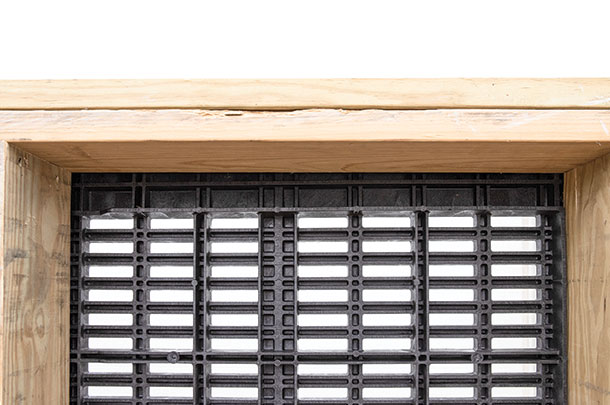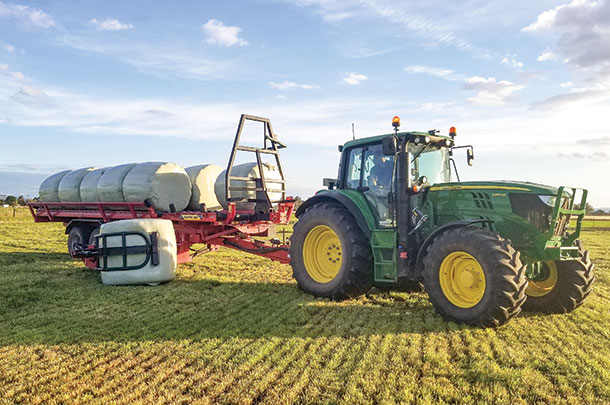Calf-Tel’s wood-slat replacement flooring

What is your new product?
Calf-Tel Flooring – a structural, plastic foam floor designed to be used with raised wood bases. The flooring can be dropped into existing, standard wood bases, replacing the common wood slat floors currently in use.
What is the history of this product?
The flooring was designed and developed as a critical component of a calf-raising system. Western-style calf raising is mainly dominated by wood bases, floors and stalls; this new flooring provides a much cleaner, durable and healthier option over wood.
Why is there a need for this product?
Wooden floors are inherently porous, absorbing bacteria and other bioburdens that are harmful to calf health and break down the wood over time. This floor is made out of a structural, plastic foam that provides flexible cushioning under the calves’ weight for added comfort under hoof and while lying down.
Additionally, the smooth plastic, combined with strategically designed floor openings, disperses waste more effectively than traditional wooden floors. The floor was designed with more open area than wooden floors, resulting in better waste pass-through and superior ventilation.
How long has this been in development?
The product has been developed over the past 18 months.
What type of producer do you think this product will most benefit?
Western-style calf raisers will benefit from this product. The wood stall systems are more prevalent on large-scale Western calf ranches, and this provides the perfect alternative to typical wood slat floors. These calf raisers benefit from the plastic flooring in many ways.
It is lightweight and easy to move for cleaning; simply spray off the floor, and it is dry within minutes. This flooring will be easier to maintain over time for the raisers. Wood needs to often be fixed or replaced; plastic flooring will last a lot longer, minimizing labor costs.
What makes this product different from other calf facility products?
This flooring provides a combination of grip, surface area and flex to provide both a comfortable and confident stance for growing calves. The plastic is easy to clean and disperses waste better than wood slat floors, keeping the calf cleaner and healthier. Wood floors are porous and absorb water and bioburdens over time, breaking down the wood and creating a breeding ground for bacteria.
When was it introduced?
The product was introduced at World Dairy Expo 2018 and will be on display at World Ag Expo.
—Answers provided by Ashley Hansen, associate marketing manager, Calf-Tel
Anderson Group’s self-loading wrapped silage bale mover

What is your new product?
The RBMPRO2000 is a self-loading wrapped silage bale mover that allows farmers to pick up wrapped bales. The implement can, with one operator and only one tractor, load up to 14 wrapped bales or 20 dry bales, transport and unload them without the need of a second tractor.
What is the history of this product?
Over the last five years, we have investigated the new trend of combination baler-wrappers in Europe. We realized moving wrapped bales was a bottleneck for many farmers. Our product enables moving wrapped bales within three hours after the wrapping process. Past that time frame, handling wrapped bales could reduce the efficiency of the oxygen-barrier protection provided by the plastic film and the crop value of the forage.
We had equipment experience in wrapping bales, and we had the experience of moving unwrapped bales. Why not try to combine that know-how together and optimize the logistics of the wrapped bale produced from a combination baler-wrapper?
Why is there a need for this product?
Contractors are often involved in harvesting wrapped bales. They prefer to wrap bales in the field because that process can be automated during harvest but leaves bales sitting in the field.
Hiring a contractor often leaves the farmer in a dilemma where he needs to either leave the bale in the field longer (three weeks) in order for the fermentation process to be complete to preserve the hay’s quality or move the bale immediately but risk a loss of quality if the wrapping is punctured.
Our new implement is the world’s first wrapped silage bale mover, and contractors involved in harvest can now offer a third service to their farmer-clients. On top of charging for baling and wrapping services, they will be able to efficiently move out of the field the wrapped bales and unload them wherever the farm owner wants them in the same day.
Farm owners will get maximum values for their crop, contractors will have more income by offering additional services, and the field will be cleared out ready to grow again with less soil compaction generated by the back-and-forth movement of a tractor moving bales.
How long has this been in development?
This project was started in December 2015, and in 2018 we manufactured 20 units.
What type of producer do you think this product will most benefit?
This product mainly benefits the farm owner (higher crop value with proper wrapped bale management), but the product targets contractors offering wrapping services.
When will it be introduced?
The product was demonstrated in private during the summer of 2018. It will be introduced for the first time publicly at World Ag Expo.
—Answers provided by Patrice Desrochers, CEO/President, Anderson Group
Semex’s female immunity genomic test
What is your new product?
Elevate is a genomic test that is an official U.S. Dairy Cattle Breeding Council genetic evaluation. It provides an exclusive evaluation of a female’s immunity to herd health challenges. This is an offshoot of our Immunity+ plus brand that Semex uses to evaluate its sires. The genetic test is based off of data from 10,000-plus cows. Animals tested as being high immune-responsive are one standard deviation above the mean. We see a 40 percent decrease in herd health treatments for these animals versus the average.
What is the history of this product?
Over the past five years, we have built a cloud interface with our client base for data collection and have been building on-farm genetic progress plans, even prior to genomic testing. We already had a lot of client information. We had clients’ intimate on-farm data about farm economics, cull rates, herd growth plans, etc. We took this data and optimized it.
We built genetic equations that run multiple evaluations of that farm and employ a similar strategy we would use to create elite female and male genetics for ourselves. It then uses the farm’s herd inventory to optimize the genetic strategy for the farm. It will identify which of the animals need to be tested given the suggested breeding strategy – not always will all animals be recommended for testing.
Why is there a need for this product?
Up to this point, genetic evaluation tests have been offered primarily by animal health companies. What producers told us was: They didn’t know what to do with the genetic evaluation data they were getting. No one has been helping producers figure out which animals need testing, or how to breed them based on the genetic evaluation results. We can provide suggestions for how to best use genetic evaluation data for a specific farm.
What type of producer do you think this product will most benefit?
The best producers have a good repro program that produces enough pregnancies. They also have a good genetic program that has started to segregate the herd’s genetics and utilizes higher-merit bulls. They are also technology-oriented. These producers recognize the cost of raising an inefficient heifer is greater than the cost of a genetic test. These are the producers who will benefit most. A producer wouldn’t have to be using our semen or even already be genetic testing to be a candidate for this service.
What makes this product different from other genetic tests?
This product identifies females by their immune response levels, offers an official CDBC genetic proof result, suggests how to use the data in a herd-specific genetic strategy and automates the tissue-collection sampling process.
When was it introduced?
2018
—Answers provided by Paul Krueger, vice president of key accounts and global solutions, Semex ![]()
PHOTO 1: Calf-Tel’s wood slat replacement flooring.
PHOTO 2: Anderson Group’s self-loading wrapped silage bale mover. Courtesy photos.

-
Walt Cooley
- Editor-in-chief
- Progressive Dairyman
- Email Walt Cooley




